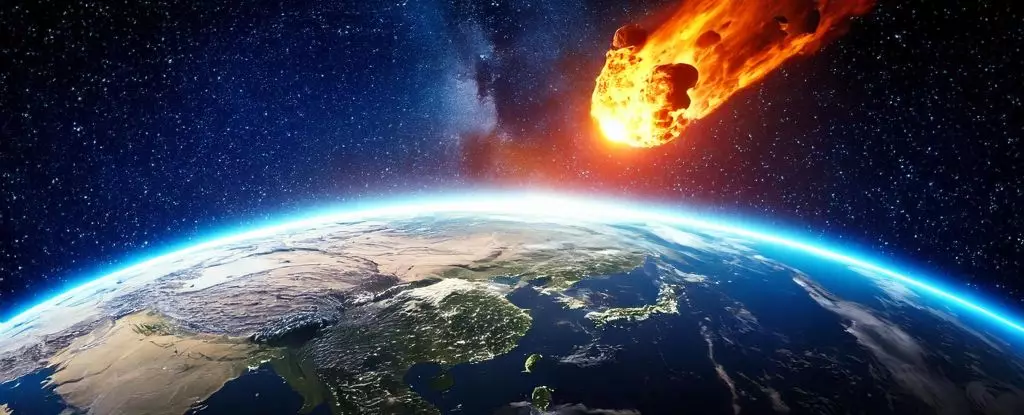While the thought of a massive asteroid colliding with Earth might seem like the plot of a sci-fi thriller, recent simulations indicate that such an event is not merely speculative fantasy. Humanity faces real threats from space, particularly from asteroids that roam the solar system. An example of this is asteroid Bennu, a hill-sized space rock that’s been identified as a potential threat, with a projected collision chance in the year 2182. Although the likelihood of an impact is relatively low—estimated at about 0.04 percent—this possibility shouldn’t be dismissed outright, as the consequences could be catastrophic.
Asteroids like Bennu—about 500 meters (1,640 feet) in diameter—are frequent travelers through our solar system and could cause severe disruptions if they were to collide with Earth. Given the historical context and the last major proven impact event (the Chicxulub impact that contributed to the dinosaurs’ extinction), it’s imperative that we examine the implications of potential asteroid collisions. Understanding these threats helps inform both public policy and scientific exploration.
Simulating Disaster: Insights from the South Korean Research Team
Researchers from Pusan National University in South Korea have embarked on a critical mission to model the consequences of such asteroid impacts. Their work has centered on simulating the environmental fallout from a collision, including atmospheric changes and effects on both terrestrial and marine ecosystems. Using the powerful Aleph supercomputer, they were able to forecast the immediate aftermath of a 500-meter asteroid striking Earth, notably examining phenomena that have been neglected in previous studies.
They discovered that a collision of this magnitude would unleash between 100 to 400 million metric tons of dust and debris into the stratosphere. This influx of particulates would not just cause a dramatic atmospheric alteration, but it would also significantly diminish sunlight reaching the Earth’s surface, leading to drastically reduced global temperatures—projected to drop by 4 degrees Celsius—and decreased precipitation by approximately 15 percent. These findings are alarming, as they unveil potential disruptions to agricultural systems and global food security.
The simulations carried out by Dai and Timmerman highlight that the repercussions of a large asteroid impact would be multifaceted and could persist for years. As atmospheric conditions deteriorate and global temperatures fall, photosynthesis, a critical process for plant life, would be severely compromised. Their research suggests that terrestrial photosynthesis could decrease by 20 to 30 percent, leading to potential famine and crisis in food supply chains.
Moreover, the impact would likely result in significant ozone depletion, estimated at around 32 percent. Such a depletion poses an existential threat to Earth’s plant life, critical for maintaining ecological balance. Plants have shown a marked sensitivity to environmental shifts; hence, a drastic decline could trigger a ripple effect throughout the food chain, further exacerbating food insecurity issues.
Interestingly, while terrestrial ecosystems may face devastation, the research also highlights some unexpected resilience among aquatic organisms. Specifically, marine algae demonstrate an ability to recover quickly from the resultant ‘impact winter.’ These algae could thrive in the conditions generated by asteroid dust, particularly due to the increased availability of iron—a nutrient that could accelerate their growth.
This surprising resilience among aquatic ecosystems provides a glimmer of hope. The researchers speculate that the proliferation of marine diatoms—important organisms in aquatic food webs—could serve as a crucial food source for zooplankton, thereby enhancing food security in oceans during periods when terrestrial systems struggle to survive. These complex interactions underline the difficulty in predicting the full range of ecological responses to a large-scale impact.
The Bigger Picture: Importance of Recognition and Preparedness
As humanity stands at a crossroads, it is crucial to recognize that while we may seem invincible, we are, in fact, vulnerable to cosmic phenomena like asteroid impacts. The understanding gleaned from simulations is vital in guiding both our response strategies and our broader awareness about the potential risks posed by asteroids.
Although significant asteroid collisions are statistically infrequent—estimated once every 100,000 to 200,000 years—the implications of such events must not be understated. The lessons from past extinction events may serve not just as history but as a blueprint for better preparing this planet for what may lie ahead. Humanity’s survival and adaptation depend on its ability to prepare, adapt, and respond to the challenges posed by celestial bodies like Bennu and its counterparts in the vast universe.


Leave a Reply